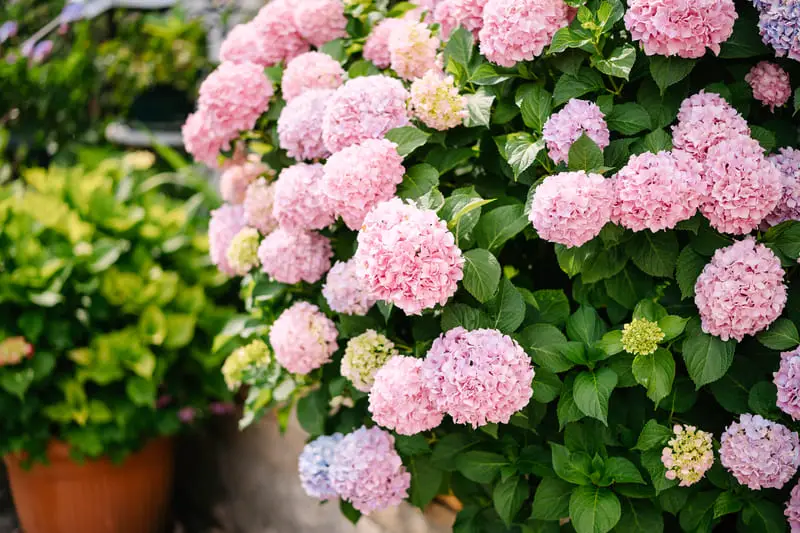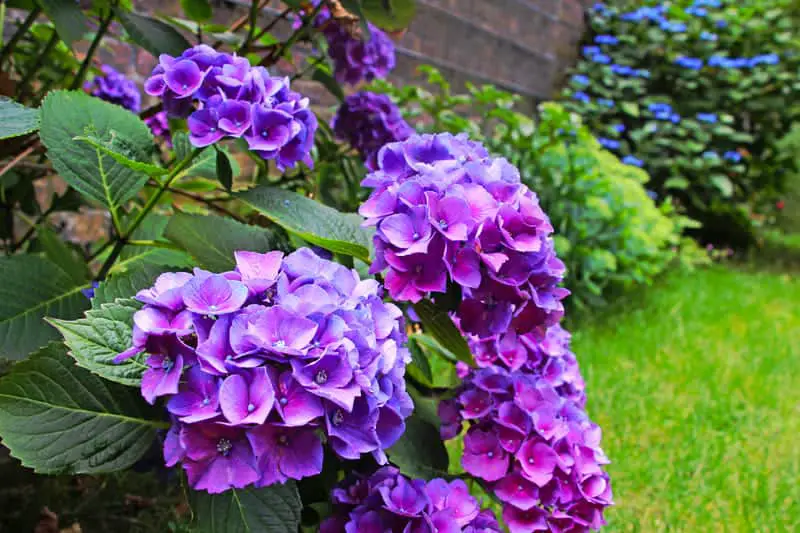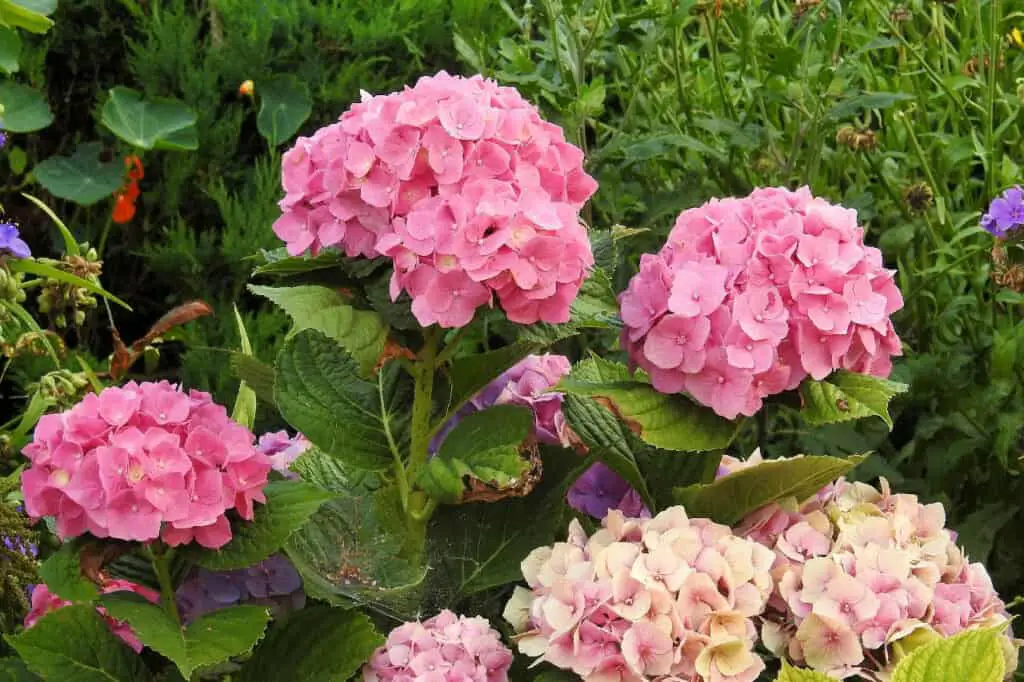Hydrangeas prefer partial shade but can tolerate some morning sun and afternoon shade. They should be protected from direct hot afternoon sun as it can scorch the leaves and cause the plant to wilt.
If planted in an area that receives full sun, it is important to provide adequate moisture and to keep the soil consistently moist, as well as to protect the plant from strong winds.
Hydrangeas can grow in full sun, but prefer some shade. They prefer filtered or dappled light, especially in areas with hot, intense sun. Too much direct sun can cause the leaves to wilt and the blooms to fade. Providing some shade, especially during the hottest part of the day, can help keep hydrangeas healthy and blooming.
If you want to grow hydrangeas in full sun, there are a few things you can do to ensure their success:
- Provide adequate moisture: Hydrangeas require consistently moist soil, so make sure to water them regularly, especially during hot and dry periods.
- Mulch the soil: A layer of mulch around the base of the plant will help retain moisture in the soil and keep the roots cool.
- Provide some shade: Consider providing some shade during the hottest part of the day by placing a shade cloth over the plant or planting it near taller plants or structures that can provide some relief from the direct sun.
- Plant in well-draining soil: Hydrangeas do not like to be waterlogged, so make sure the soil you plant them in has good drainage.
- Protect from strong winds: Hydrangeas are susceptible to damage from strong winds, so consider planting them in an area that is protected from the wind or staking them to provide additional support.
- Regularly check for pests and diseases: Hydrangeas are susceptible to pests and diseases, so regularly check the plant for any signs of infestation or infection and take appropriate action if necessary.
Note:
Neem oil is a natural insecticide and fungicide that can be used to help control pests and diseases on hydrangeas. When used as directed, neem oil can be an effective way to protect hydrangeas from common pests such as spider mites, aphids, and whiteflies, as well as fungal diseases such as powdery mildew.
Also check: Hydrangea Leaves Turning Yellow
When using neem oil on hydrangeas, it is important to follow the instructions on the product label carefully.
Remember that even if you follow these steps, hydrangeas may not thrive as well in full sun as they would in partial shade.
Below I have supplied a few options for hydrangeas that are better suited to full sun and will discuss the different soil conditions and moisture content that should be applied when caring for your favorite garden flower. I will also outline some ideas on how to DIY your garden to be more hydrangea friendly.
Hydrangeas That tolerate Full Sun
There are a few types of hydrangeas that are more tolerant of full sun than others. Some examples include:
- Oakleaf Hydrangea (Hydrangea quercifolia): This type of hydrangea is native to the south-eastern United States and is known for its tolerance of full sun.
- Paniculata hydrangeas (Hydrangea paniculata): This species can take full sun and tolerate a wide range of soil conditions.
- Smooth Hydrangea (Hydrangea arborescens): This type of hydrangea is also more tolerant of full sun than other species.
- Cityline Paris (Hydrangea macrophylla): This type of hydrangea has dark green foliage and scarlet flowers and will do well in full sun.
It’s worth noting that even though these hydrangeas are more tolerant of full sun, they still require consistent moisture and protection from strong winds. It’s also important to make sure that the soil is well-draining, and to provide shade during the hottest part of the day.
It’s also worth mentioning that if you live in a region with extreme heat or prolonged droughts, it might be difficult to keep hydrangeas healthy, even with the most sun-tolerant varieties.
If the wrong type of hydrangeas (and sometimes even the right) are planted in full sun, they may experience a number of problems, including:
Scorched leaves: The leaves of the plant may become scorched or discolored from exposure to direct hot afternoon sun.
Wilting: The plant may wilt or droop from the heat and lack of moisture.
Reduced blooming: Hydrangeas typically bloom less in full sun than they do in partial shade.
Increased susceptibility to pests and diseases: Hydrangeas planted in full sun may be more susceptible to pests and diseases than those planted in partial shade.
Drought stress: Because hydrangeas need consistent moisture, they may experience drought stress if they are not watered regularly when planted in full sun.
It’s important to note that hydrangeas can adapt to full sun if they are provided with adequate moisture, protection from strong winds, and shade during the hottest part of the day, but even then they may not thrive as well as in partial shade.
It really depends on your regional weather, soil conditions, access to water and how much time you want to invest in your beauties! Just like anything, the more we put into it, the more we are going to get out of it.
There is research that suggests that certain types of hydrangeas, such as Oakleaf Hydrangea (Hydrangea quercifolia) and Paniculata hydrangeas (Hydrangea paniculata) can tolerate full sun.
For example, a study published in the Journal of Environmental Horticulture found that Oakleaf Hydrangea performed well in full sun, with no significant difference in growth or blooming compared to plants grown in partial shade.
More: How To Deadhead Hydrangeas
Another study published in the Journal of Plant Research found that Paniculata hydrangea cultivars were tolerant to full sun and thrived well in this environment.
However, it’s important to note that even in the studies that have been done, the hydrangeas were provided with adequate moisture and protection from strong winds and shade during the hottest part of the day.
Also, if you live in a region with extreme heat or prolonged droughts, it might be difficult to keep hydrangeas healthy in full sun.
Full sun can also vary greatly depending on the location. For example, a full sun location in Arizona will have different intensity and duration of sunlight than a full sun location in Maine, or indeed in New Zealand where the ozone is thinner.
Soil conditions also make a difference; the nutrient content, ground water and amount of clay will determine if the hydrangea is apt to grow and flourish.
Therefore, it’s important to consider the specific growing conditions in your area when determining whether full sun is appropriate for your hydrangeas.
Ideal soil conditions for hydrangeas:
Hydrangeas prefer well-drained, moist, and slightly acidic soil with a pH between 5.5 and 6.5.
Drainage: Hydrangeas do not like to be waterlogged, so it’s important to plant them in soil that has good drainage. If your soil is heavy clay, you may need to amend it with organic matter, such as compost or peat moss, to improve drainage.
Moisture: Hydrangeas require consistently moist soil, so make sure to water them regularly, especially during hot and dry periods. Watering early in the morning or later in the evening can help the soil retain moisture better as there is less evaporation.
pH: Hydrangeas prefer slightly acidic soil, with a pH between 5.5 and 6.5. If your soil is too alkaline, you can add sulfur to lower the pH. If you are unsure about the pH of your soil, you can test it with a soil test kit available from The Home Depot from $18.57, or any other garden center.
Organic matter: Adding organic matter, such as compost or aged manure, to the soil can help improve its structure and water-holding capacity.
Fertilizer: Hydrangeas can benefit from regular fertilization, especially with a balanced fertilizer that contains equal parts of nitrogen, phosphorous, and potassium (NPK) or an acid-based fertilizer specifically formulated for acid-loving plants.
It’s worth noting that some hydrangeas can adapt to a wide range of soil conditions but providing ideal soil condition will help the plants thrive.
Here are a few ideas on how to DIY your garden to make it more hydrangea-friendly:
Create a shade garden:
Hydrangeas prefer partial shade, so consider planting them in an area of your garden that receives morning sun and afternoon shade.
You can create a shade garden by planting tall trees or shrubs that will provide dappled shade, or by installing a shade cloth over the area.
Build a raised bed: If your soil is heavy clay or poorly drained, consider building a raised bed for your hydrangeas. This will allow you to create the ideal soil conditions for the plants and ensure that they are not waterlogged. This also helps my back, as I am quite tall and it’s a long way to the ground!
Mulch the soil: A layer of mulch around the base of the hydrangeas will help retain moisture in the soil and keep the roots cool. It will also suppress weeds, which can compete with your hydrangea for resources. Weed mat is another option, though often less environmentally friendly than bark or straw mulch.
Install a drip irrigation system: Hydrangeas require consistent moisture, so consider installing a drip irrigation system that will allow you to water the plants at the base of the plant, where the roots are, rather than on the leaves. Drip irrigation systems are available from most nurseries, The Home Depot, and garden centers, etc…
Add organic matter: Adding organic matter, such as compost or aged manure, to the soil can help improve its structure and water-holding capacity. It will also feed the plants with slow release of nutrients. Composting is a great way to reduce your carbon footprint and food waste as well.
Test soil pH: If you are unsure about the pH of your soil, you can test it with a soil test kit, which is widely available in home improvement or gardening stores. If the pH is too alkaline, you can add sulfur to lower it to the preferred range of 5.5-6.5.
Prune and shape your hydrangeas: Regular pruning will help keep your hydrangeas healthy and looking their best. The pruning techniques will vary depending on the variety of hydrangea you have, so be sure to research the specific pruning needs of your plants.
Alexandra from The Middle-Sized Garden. a journalist and author, who has worked for Britain’s top magazines & newspapers, has a fantastic 10-minute video about hydrangea care that is easy to follow and extremely informative.
She speaks with Roger Butler, a hydrangea specialist of Signature Hydrangeas in Kent about tips and tricks to make your hydrangeas the source of your neighbour’s envy.
She answers many questions including: How to choose and care for hydrangeas. How to understand whether a hydrangea will change colour. Choosing the right hydrangea for your garden, and what is the best time of year to plant a hydrangea.
On the opposite end of the spectrum, let’s look at the question:
Can Hydrangeas Grown In Full Shade?
Hydrangeas can tolerate full shade, but they may not thrive as well as they would in partial shade or dappled sunlight. They may produce fewer blooms and have a weaker growth.
In addition, full shade can also lead to disease and pest issues as the leaves will stay damp for longer periods of time.
It’s worth noting that while hydrangeas can tolerate full shade, they will still require consistent moisture and protection from strong winds, and regular fertilization to ensure the best possible growth.
And if you live in a region with extreme heat or cold or prolonged droughts/wet seasons, it might be difficult to keep hydrangeas healthy in full shade.
To wrap it up, some advice on the best place to plant a hydrangea:
The best place to plant a hydrangea will depend on the specific growing conditions of your area and the type of hydrangea you have.
In general (and this is general information, you should always do research on your specific type of hydrangea before planting), hydrangeas prefer:
Partial shade: Hydrangeas prefer partial shade, so they should be planted in an area that receives morning sun and afternoon shade. They should be protected from direct hot afternoon sun as it can scorch the leaves and cause the plant to wilt.
Consistently moist soil: Hydrangeas require consistently moist soil, so make sure to plant them in an area that receives regular watering or that is near a water source.
Well-draining soil: Hydrangeas do not like to be waterlogged, so make sure the soil you plant them in has good drainage. If your soil is heavy clay, you may need to amend it with organic matter, such as compost or peat moss, to improve drainage.
Protection from strong winds: Hydrangeas are susceptible to damage from strong winds, so consider planting them in an area that is protected from the wind or staking them to provide additional support.
Protection from extreme heat or prolonged droughts: If you live in a region with extreme heat or prolonged droughts, it might be difficult to keep hydrangeas healthy, even in the best conditions.
Consider the size of the plant: Some hydrangeas can get quite large and may require more space than others. Be sure to research the specific size and growth habits of your hydrangea variety and plant it in a location that can accommodate those needs.
It’s also important to consider the specific growing conditions in your area and the variety of hydrangea you have when determining the best place to plant it.
Hope this helped and happy growing!




